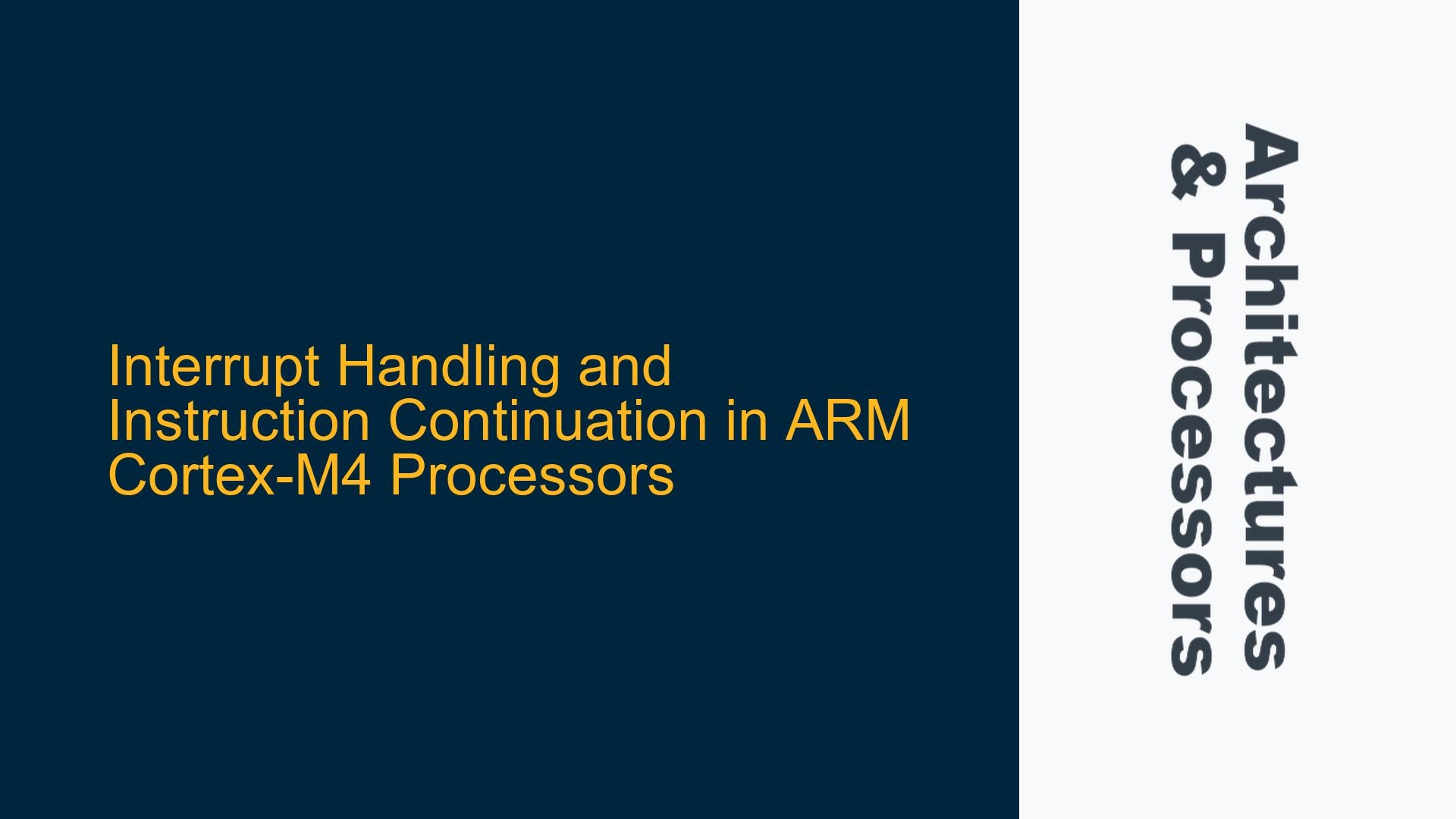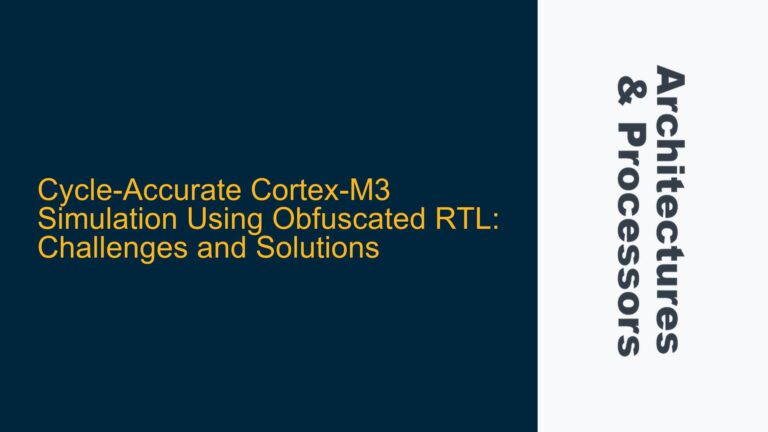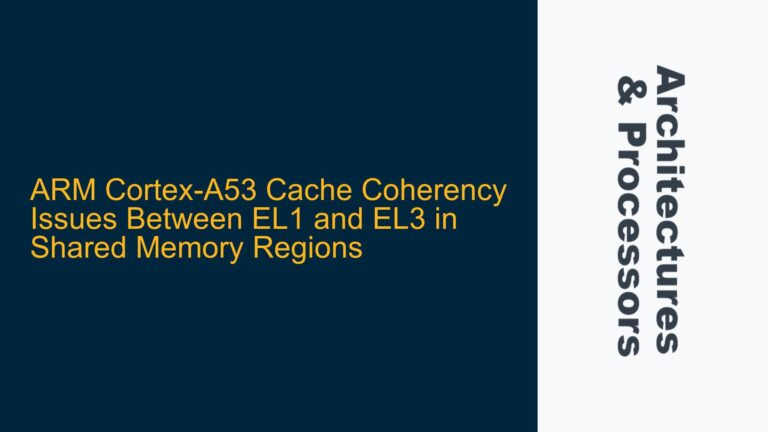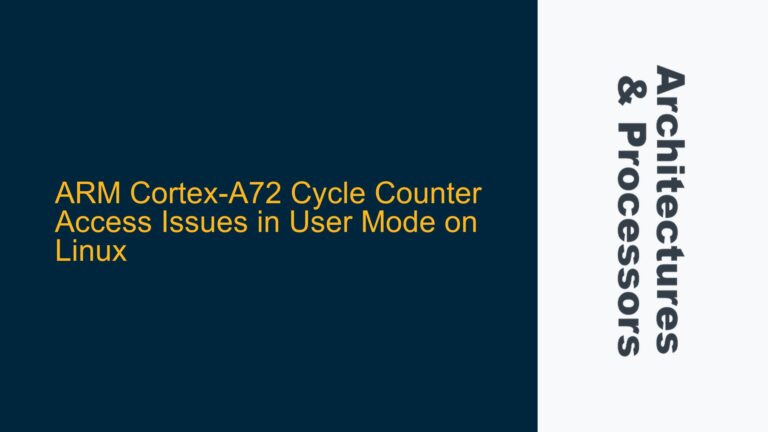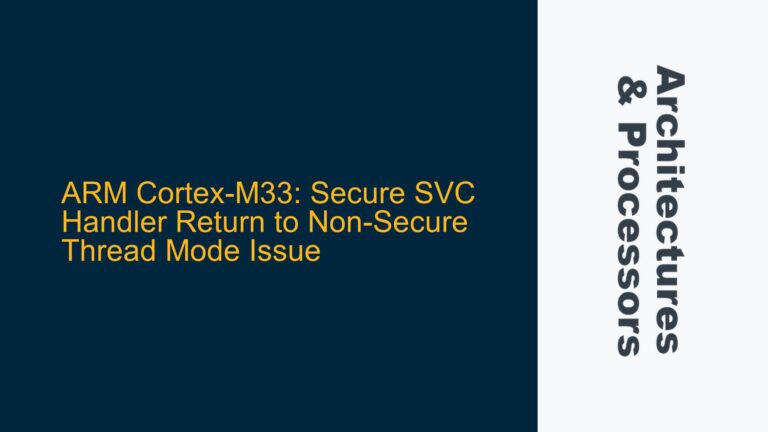Interruptible Instructions and Their Impact on Cortex-M4 Execution Flow
The ARM Cortex-M4 processor, like other members of the Cortex-M family, is designed to handle interrupts efficiently, minimizing latency and ensuring deterministic behavior. However, the interaction between interrupt handling and instruction execution is nuanced, particularly when dealing with multi-cycle instructions. Understanding how the Cortex-M4 handles interruptible instructions is critical for developers aiming to optimize performance, ensure atomicity, and avoid subtle bugs in real-time systems.
The Cortex-M4 processor supports several types of interruptible instructions, including divide operations (UDIV/SDIV), double-word load/store operations (LDRD/STRD), and multiple load/store operations (LDM/STM). These instructions are interruptible in different ways, and their behavior during interrupts can significantly impact system performance and correctness. For example, divide instructions are abandoned and restarted after an interrupt, while LDM/STM operations are paused and resumed using the Interrupt-Continuable Instruction (ICI) mechanism. This distinction is crucial for developers who need to ensure atomicity or avoid unintended side effects, such as reading peripheral registers multiple times due to interrupted double-word loads.
The Cortex-M4’s handling of interruptible instructions is further complicated by the presence of floating-point unit (FPU) operations, which can continue execution in parallel with interrupt stacking. This behavior introduces additional considerations for developers, particularly when dealing with mixed integer and floating-point workloads. Understanding these mechanisms is essential for writing efficient and reliable firmware, especially in systems with strict timing requirements or complex interrupt handling logic.
Divide, Double-Word Load/Store, and LDM/STM Interruptibility Mechanisms
The Cortex-M4 processor implements distinct mechanisms for handling interrupts during the execution of multi-cycle instructions. These mechanisms are designed to balance interrupt latency and instruction completion, but they introduce specific behaviors that developers must account for in their designs.
Divide Instructions (UDIV/SDIV)
Divide instructions on the Cortex-M4 are multi-cycle operations that can be interrupted. When an interrupt occurs during a divide operation, the processor abandons the instruction and services the interrupt. After the interrupt handler completes, the divide instruction is restarted from the beginning. This behavior ensures low interrupt latency but can lead to performance overhead if interrupts occur frequently during divide operations. Developers must be aware of this restart behavior, particularly in time-critical applications where repeated divide operations could impact system responsiveness.
Double-Word Load/Store Instructions (LDRD/STRD)
Double-word load and store instructions are also interruptible on the Cortex-M4. When an interrupt occurs during an LDRD or STRD operation, the instruction is abandoned and restarted after the interrupt handler completes. This behavior can have significant implications for peripheral access, as restarting a double-word load may result in the same memory location being read multiple times. For example, if an LDRD instruction is used to read a 64-bit peripheral register, an interrupt occurring during the operation could cause the low word to be read twice. This can disturb peripherals that rely on atomic access or have side effects on read operations.
Multiple Load/Store Instructions (LDM/STM)
Unlike divide and double-word load/store instructions, multiple load/store operations on the Cortex-M4 are handled using the Interrupt-Continuable Instruction (ICI) mechanism. When an interrupt occurs during an LDM or STM operation, the processor completes the current memory access and saves the next register number in the stacked Program Status Register (PSR). After the interrupt handler completes, the LDM/STM operation resumes from the point where it was interrupted. This mechanism ensures that LDM/STM operations are not restarted from the beginning, reducing the overhead associated with interrupt handling.
The ICI mechanism is particularly useful for stack operations (PUSH/POP), which are commonly used in function prologues and epilogues. By allowing these operations to be interrupted and resumed, the Cortex-M4 minimizes the impact of interrupts on stack management and function call overhead. However, developers must still be cautious when using LDM/STM instructions to access peripheral registers, as the resumed operation may result in unintended side effects or non-atomic access.
Floating-Point Unit (FPU) Operations
The Cortex-M4’s FPU introduces additional complexity to interrupt handling. Floating-point operations are multi-cycle instructions that can continue execution in parallel with interrupt stacking. This behavior allows the FPU to make progress on floating-point computations while the processor handles interrupts, improving overall system performance. However, developers must ensure that floating-point context is properly saved and restored during interrupt handling, particularly in systems with mixed integer and floating-point workloads.
Strategies for Managing Interruptible Instructions in Cortex-M4 Systems
Managing interruptible instructions on the Cortex-M4 requires a combination of architectural understanding, careful design, and targeted optimizations. Below are detailed strategies for addressing the challenges associated with interruptible instructions, ensuring atomicity, and minimizing performance overhead.
Ensuring Atomic Access to Peripheral Registers
One of the primary challenges associated with interruptible instructions is ensuring atomic access to peripheral registers. This is particularly important for peripherals that rely on atomic read-modify-write operations or have side effects on read operations. To address this challenge, developers can use the following strategies:
-
Avoid Double-Word Load/Store Instructions for Peripheral Access: Since LDRD and STRD instructions are not atomic and can be restarted after an interrupt, they should be avoided when accessing peripheral registers. Instead, use single-word load/store instructions (LDR/STR) to ensure atomic access.
-
Use Critical Sections for Atomic Operations: For operations that require atomicity, such as read-modify-write sequences, use critical sections to disable interrupts during the operation. This ensures that the operation completes without being interrupted, preventing race conditions or unintended side effects.
-
Leverage Hardware Features for Atomic Access: Some Cortex-M4 microcontrollers provide hardware features, such as bit-banding or atomic set/clear registers, that enable atomic access to specific bits or registers. These features can be used to simplify the implementation of atomic operations without requiring critical sections.
Minimizing Interrupt Latency and Overhead
Interrupt latency and overhead are critical considerations in real-time systems, particularly when dealing with interruptible instructions. The following strategies can help minimize the impact of interrupts on system performance:
-
Optimize Interrupt Handlers: Keep interrupt handlers as short as possible to minimize the time spent in interrupt context. This reduces the likelihood of interrupts occurring during multi-cycle instructions and minimizes the overhead associated with instruction restart or continuation.
-
Use Low-Priority Interrupts for Non-Critical Tasks: For tasks that do not require immediate attention, use low-priority interrupts to reduce the frequency of high-priority interrupts. This can help minimize the impact of interrupts on time-critical operations, such as divide or floating-point instructions.
-
Leverage the ICI Mechanism for LDM/STM Operations: When using LDM/STM instructions, ensure that they are used in contexts where the ICI mechanism can provide benefits, such as stack operations. Avoid using LDM/STM for peripheral access, as the resumed operation may result in unintended side effects.
Handling Floating-Point Operations in Interrupt Context
The Cortex-M4’s FPU introduces additional considerations for interrupt handling, particularly in systems with mixed integer and floating-point workloads. The following strategies can help manage floating-point operations in interrupt context:
-
Save and Restore Floating-Point Context: When using the FPU in interrupt handlers, ensure that the floating-point context is properly saved and restored. This includes saving and restoring the FPU registers and control registers, such as the Floating-Point Status and Control Register (FPSCR).
-
Use Lazy Stacking for Floating-Point Context: The Cortex-M4 supports lazy stacking of floating-point registers, which defers the saving of FPU context until it is actually used in the interrupt handler. This can reduce the overhead associated with interrupt handling, particularly in systems where floating-point operations are infrequent.
-
Avoid Floating-Point Operations in High-Priority Interrupts: For high-priority interrupts that require low latency, avoid using floating-point operations to minimize the time spent in interrupt context. Instead, defer floating-point computations to lower-priority tasks or the main application loop.
Debugging and Profiling Interruptible Instructions
Debugging and profiling interruptible instructions can be challenging due to their interaction with interrupt handling. The following strategies can help identify and address issues related to interruptible instructions:
-
Use Debugging Tools to Monitor Instruction Execution: ARM debugging tools, such as the Embedded Trace Macrocell (ETM) or Serial Wire Viewer (SWV), can be used to monitor instruction execution and identify instances where instructions are interrupted and restarted. This can help pinpoint performance bottlenecks or unintended side effects.
-
Profile Interrupt Handling Overhead: Use profiling tools to measure the overhead associated with interrupt handling, particularly for multi-cycle instructions. This can help identify opportunities for optimization, such as reducing the frequency of high-priority interrupts or optimizing interrupt handlers.
-
Simulate Interrupt Scenarios: Use simulation tools to test the behavior of interruptible instructions under different interrupt scenarios. This can help validate the correctness of interrupt handling logic and ensure that the system behaves as expected under real-world conditions.
Best Practices for Cortex-M4 Interrupt Handling
To summarize, the following best practices can help developers effectively manage interruptible instructions on the Cortex-M4:
-
Understand the Behavior of Interruptible Instructions: Familiarize yourself with the specific behaviors of divide, double-word load/store, and LDM/STM instructions, as well as the ICI mechanism and FPU operations.
-
Ensure Atomic Access to Peripheral Registers: Avoid using non-atomic instructions, such as LDRD and STRD, for peripheral access. Use critical sections or hardware features to ensure atomicity when necessary.
-
Optimize Interrupt Handling: Minimize interrupt latency and overhead by optimizing interrupt handlers, using low-priority interrupts for non-critical tasks, and leveraging the ICI mechanism for LDM/STM operations.
-
Manage Floating-Point Context: Properly save and restore floating-point context in interrupt handlers, and avoid using floating-point operations in high-priority interrupts.
-
Debug and Profile System Behavior: Use debugging and profiling tools to monitor instruction execution, measure interrupt handling overhead, and simulate interrupt scenarios.
By following these strategies and best practices, developers can effectively manage interruptible instructions on the Cortex-M4, ensuring reliable and efficient system performance.
